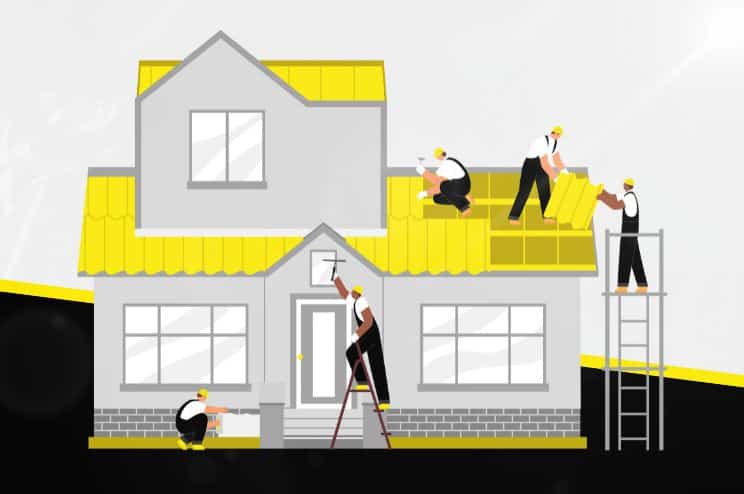What is siding? Just a nice cover for the structure of your home? Well, yes. But it’s much more. It’s that critical component of your house that protects against the elements and effects curb appeal like nothing else.
Regular maintenance is essential to keep it looking new and functioning properly.
Whether your home is clad in vinyl, wood, fiber cement, or another material, understanding the basics of siding care can significantly extend its lifespan and preserve its beauty.
Routine Cleaning
Ideally, siding should be cleaned at least once a year, with inspections every spring and fall. These seasons are perfect because they precede the more extreme weather of summer and winter, which can exacerbate any existing issues. Here are a few quick tips for cleaning your siding:
- Preparation: Start by ensuring all windows and doors are closed and any outdoor furniture is moved away from the house.
- Washing: Use a soft cloth or a soft bristle brush with a mixture of mild soap and water. For vinyl and fiber cement, a power washer on a low setting can be effective but use caution to avoid water penetration behind the siding.
- Rinsing: Thoroughly rinse the siding with clean water to prevent residue buildup which can attract dirt and grime.
Just remember to avoid harsh chemicals that can damage the siding’s finish. For mold or mildew, a solution of 70% water and 30% white vinegar can be effective, especially on tougher materials like fiber cement.
Inspection and Repairs
Don’t overlook the importance of regular inspections. This will ensure that you catch issues before they become major problems. Look for cracks, warping, loose pieces, and signs of moisture or mold. Pay special attention to areas around windows and doors where water might collect. Small cracks or holes can often be repaired with caulk designed for exterior use. For wood siding, occasionally replace split or damaged boards to prevent further damage. Always ensure that repairs are painted or sealed to match the existing siding.
Preventative Measures
Protecting your siding is about more than knowing how to deal with issues once they arrive; it’s about preventing them as much as you can.
Landscaping and Runoff: Keep trees and shrubs trimmed back from your home to prevent them from scratching or abrading the siding. Ensure gutters are clean and downspouts direct water away from the foundation to prevent water damage.
Protective Products: Use paints and sealants that offer UV protection to prevent fading and weather damage. For areas with extreme weather, consider products designed to resist wind and thermal distortion.
When is it Time to Upgrade Your Siding?
If your siding requires frequent repairs or has become inefficient in protecting your home, it might be time to upgrade. It may seem like an expensive job upfront but just remember, between the time and products needed to keep up with older siding, it may actually be a wise financial decision in the long run. New materials can offer better energy efficiency, are easier to maintain, and can increase your home’s value.
What’s the Takeaway?
Maintaining your home’s siding is a critical aspect of homeownership that enhances both the appearance and functional integrity of your property. Regular cleaning, timely repairs, and proactive upgrades can protect your investment for years to come. Always stay vigilant about the condition of your siding and act promptly to address any issues. With proper care, your home’s exterior will continue to look its best and stand strong against the environment!
Need help assessing the state of your siding? Walker Roofing and Siding is here to help. When it comes to maintaining our customers’ homes, you can be sure–we’re on your side!
Frequently Asked Questions
Q: What is the best way to remove mold or mildew from siding?
A: Use a solution of 70% water and 30% white vinegar, applying it with a soft brush. Rinse thoroughly after cleaning.
Q: How often should siding be replaced?
A: This depends on the material and how well it’s maintained, but typically siding can last from 20 to 40 years. Regular inspections will guide your replacement timing.
Q: Can I paint all types of siding? What kind of paint should I use?
A: Most types of siding can be painted, but always check the manufacturer’s recommendations. Use exterior paint designed for the siding material, often acrylic for vinyl and latex for wood.
Q: How do I know if my siding is properly installed?
A: Proper installation includes tight seams, correctly installed flashing, and no buckling or warping. Signs of poor installation include visible gaps or consistent moisture issues.
Q: What are the signs that my siding needs immediate attention?
A: Large cracks, widespread discoloration, mold growth, and increased energy bills can all be indicators that your siding needs immediate repair or replacement.

